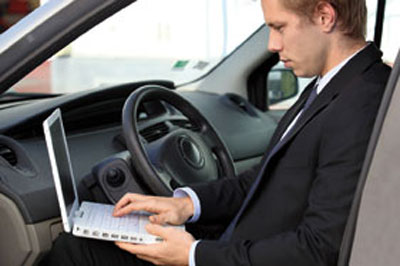Business Auto Deductions

Do you drive your car for business purposes? The costs of operating and maintaining your vehicle are potentially deductible. Here are some guidelines.
Two Methods
The IRS provides two basic methods for computing deductions for the business use of an automobile.
Actual expense method. With the actual expense method, you deduct the actual costs of operation, including licenses, regi-stration fees, garage rent, repairs, gas, oil, tolls, and insurance. Additionally, you may claim depreciation deductions (and/or elect expensing under Section 179). If the car is leased, you deduct your lease payments rather than depreciation. (Certain limits apply.)
Standard mileage rate. Alternatively, you may choose to use an IRS-provided standard mileage rate. With this method, you multiply the number of business miles you drive during the year by the applicable rate (57.5¢ per mile for 2015). When you use the standard mileage rate, you don't separately deduct expenses such as gasoline, oil, insurance, repairs and maintenance, depreciation, or lease payments. However, business-related parking fees and tolls are separately deductible.
man in car on laptop
Which Should You Use?
Generally, you will want to use the method that produces the largest deduction. If your vehicle is costly to own and operate, the actual expense method may be more advantageous. Conversely, if your vehicle is fuel efficient and/or inexpensive, the simpler standard mileage rate method may be a better choice.
With either method, the IRS requires that you keep records that substantiate your business use of the car: the date, place, business purpose, and number of miles you travel. When you use the actual expense method, you'll also need records substantiating the amount and date of car-related expenditures. You can avoid having to retain receipts by using the standard mileage rate.
If you decide to use the standard mileage rate for a car you
own, you may switch to deducting your actual business-related car expenses in a later year. However, you won't be able to claim accelerated depreciation deductions for the car. With a leased car, you have less flexibility. If you choose the standard mileage rate the first year, you must use it for the entire lease period.
Personal and Business Use
If you use your car for both personal and business purposes, you must keep track of your mileage for each purpose. To figure the percentage of qualified business use, you divide the business mileage by the total mileage driven. Then multiply that percentage by your total expenses.
Inheriting an IRA
If you inherit an individual retirement account (IRA), you'll want to be aware of the tax law's required minimum distribution (RMD) rules. Basically, you must withdraw minimum amounts from an inherited IRA by specific deadlines to avoid penalty.
You'll be taxed on your withdrawals from a traditional IRA (except for any amounts that were contributed after tax). Withdrawals from a Roth IRA are tax free when certain conditions have been met.
Spreading withdrawals over your life expectancy, if allowed, lets you spread out any tax liability and keep the rest of the account tax deferred. You take your first withdrawal by the end of the year following the year of the account owner's death and annually after that. You always have the option of taking the money out sooner if desired.
As the surviving spouse of the account owner, you have additional options that we'd be happy to explain.
2015 Mar Pg 01


